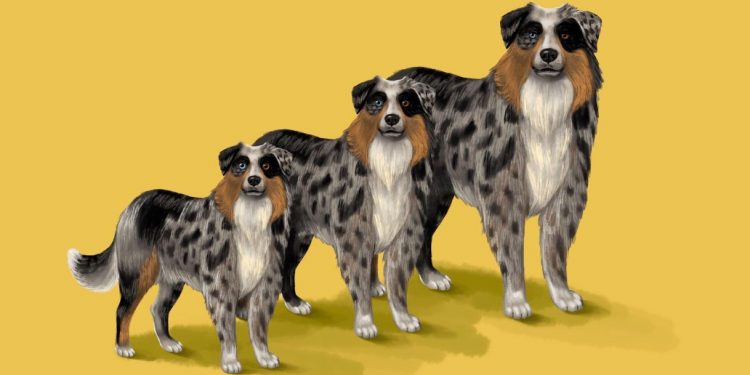Part of The Animals Issue of The Highlight, our home for ambitious stories that explain our world.
In 2021, the French bulldog, commonly known as a Frenchie, became the second most popular dog breed in America.
If there’s an “It” breed of the 21st century so far, it’s these dogs, with their squat figures, flat faces, and outsize bat ears. American Kennel Club registrations for the breed have risen steadily for over a decade, growing by 830 percent since 2009. At around 20 pounds and perfectly sized for carry-on luggage, Frenchies have been marketed as the dog best suited to the lifestyles of the rich and quite possibly lazy. They don’t even need much exercise, for the simple reason that their numerous health problems can make too much exercise dangerous.
Rather than requiring human owners to change their lives to accommodate a new dog, the French bulldog is a breed that’s been broken to accommodate us. It’s not uncommon for Frenchies (like other small, trendy dog breeds) to be “housetrained” to exclusively go to the bathroom on pee pads, litter boxes, or turfgrass inside an apartment or on a balcony.
In 2018, they were the most popular pup in New York, Los Angeles, and San Francisco and the top five in many other cities. (The only breed more popular in America for the past 30 years has been the Labrador retriever.) The Frenchie is the most hashtagged dog on Instagram. It’s in ads, on television, and a celebrity favorite. Demand for them is so high that they can easily cost up to $5,000; there’s enough money in them that they have inspired multiple robberies, most famously earlier this year, when Lady Gaga’s dog walker was shot and two of her Frenchies, Koji and Gustav, were stolen.
Part of the reason for Frenchies’ exorbitant cost is that the dogs’ heads are so large that litters usually have to be delivered via C-section, an expensive veterinary procedure. The dogs can also cost their owners thousands of dollars down the line, because they’re prone to a multitude of health problems, including skin, eye, and ear infections. There are also breathing issues common to all brachycephalic breeds — those with flat faces — that can cause respiratory distress, heat intolerance (since the dogs have to pant to cool themselves off), and frequent vomiting. Later in life, Frenchies can show signs of more serious issues like painful spine deformations and nerve pain.
Read Also: Discover Your Perfect Bully Breed Companion
Some of these health issues can be lessened by careful breeding (versus buying from a high-volume breeder, more commonly known as a puppy mill), but many are a direct result of the appearance people want their Frenchies to have — the expressive faces with large ears and eyes that make it seem like they’re always paying attention to us. (A 2017 study published in Animal Welfare found that people who buy brachycephalic breeds do so primarily for the dogs’ looks, followed by the bwell-suitedsuited they were to the owner’s lifestyle.)
The Frenchie’s appeal isn’t just aesthetic but vaguely narcissistic. “We’ve bred them to look more like us,” says Alexandra Horowitz, a dog cognition expert and author of Our Dogs, Ourselves. They have a small nose that’s closer to their faces; their eyes are more wide-set; even their “smile” is vaguely human. When they vocalize or “talk,” it eerily mimics the tones of human speech. Frenchies make it easy for owners to project themselves onto their dogs without having to listen to what the dogually saying.
“If my husband hadn’t wanted one, I wouldn’t want to financially support the industry,” says Alana DeForest, 44, who has two Frenchies. Rather than buying a puppy, she spent years contacting rescues before she adopted her first one, Wu, followed by Donut a year later. “For me, it was a way to show my love for my husband to push this ball up the hill of finding a Frenchie.”
DeForest acknowledges the breed’s many health problems. “That said,” she says, “they are so adorable and sweet.” When she goes out with Wu and Donut, too, ptendndency to fawn all over them.
Having a Frenchie has made her feel like she’s part of an exclusive club. A restaurant near their home in Kansas City, Missouri, even hosts “Frenchie Fridays” once a month. She likens people with the squat, distinctive dogs to those who bought the DeLorean car in the 1980s: “In our corporate culture where everyone has the same Honda Civic, people crave individuality.” Now that Frenchies are so popular, it’s like people are standing out in the crowd, together.
After all, she says, “it’s human nature to want to belong.”
In 1934, writer Dodie Smith’s future husband came home with a birthday present for her. He told her it was a hat, but then, Smith told an interviewer in 1979, “the hat box began t,o roll, and out of it came a Dalmatian puppy.” The puppy, who she named Pongo, was mostly white. “The spots come later,” Smith would famously write. She fell in love with the breed, and when Pongo died, she got two more Dalmatians — a male and a female — who went on to produce a giant litter of 15 puppies. Smith’s Dalmatians inspired her to write a children’s book, which was adapted into one of the best-known Disney movies of all time: One Hundred and One Dalmatians.
The 1961 animated movie was extremely popular, making $14 million in the United States that year and setting off a craze for the personable dogs. Breeder classified ads in newspapers were evidence of the trend: Before the movie’s release, most only had one listing for Dalmatian puppies, but in the following years, major newspapers regularly had between five and nine different breeders selling the spotted dogs.
When a live-action remake of the movie came out in 1996, their popularity surged again. This time, though, the press began reporting on a perhaps predictable consequence: Dalmatians were winding up in shelters in higher-than-usual numbers. “Someone turned in a Dalmatian, and when we asked why, they said, ‘They aren’t acting like the dog in the movie,’” recalls spcaLA president Madeline Bernstein. “They see a trained dog and think all those dogs will act that way.”
Frenchies and Dalmatians are just two in a long line of breeds that have become must-have accessories for pet owners. Lassie and Rin Tin Tin kept Collies and German shepherds popular for decades. Social media and fashion’s recent butt obsession may have helped propel the waddling Corgi into the spotlight. Travel-size mini-Aussies, with their colorful coats and tendency toward eye colors more often found in humans, also had a moment. And untold curly-haired hybrid doodles have become popular thanks to their hypoallergenic fur.
On Instagram, the most popular dog breeds currently are Frenchies, pugs, and bulldogs, which, in turn, only make them more popular. Their flat faces scream cute while the high prices for a puppy make them as aspirational as multiskincaren care routines, Le Creuset kitchenware, and living in a remodeled van.
But as Life magazine noted back in 1958, even before the great Dalmatian era, “The more prestige a breed gets, the worse its future becomes.”
What are people buying when they pick out a purebred or designer dog? Literature from the American Kennel Club, which assesses whether a dog is purebred by looking at the dog’s parentage, often describes breeds’ ancient origins. According to the AKC, the bulldog was “created in 13th-century England” during the reign of King John. Of the Afghan hound it says, “An ancient myth says that a brace of Afghan Hounds represented the canine species on Noah’s Ark.” Every breed has an origin story like this — the older the beteven thought that every single purebred dog can only be traced back to Victorian England.
Before roughly 1860, people used words like “kind,” “strain,” or “variety” to describe different dogs, write the authors of The Invention of the Modern Dog: Breed and Blood in Victorian Britain. Dogs were bred for purpose, not aesthetics. A foxhound in one part of the country was taller or shorter depending on the style of hunting. Retrievers were any dog a hunter trained to reta rieve game without biting it. Greyhounds looked different depending on whether their intended racing course was located on flat or hilly ground.
The change from purpose to aesthetics came about with the beginning of dog shows in the mid-1800s. Judging animals based on how well they did a certain task, like retrieving a bird their owner hunted, was hard; judging whether they were the right color, height, shape … well, that could be done quickly and seemingly more fairly.
Once breed clubs decided on the definition of their breeds, studbooks for organizations like the AKC were “closed.” In other words, all future “purebred dogs” had to be offspring of the original dogs that fit these standards. So, by definition, all purebred dogs are in and bred, related to each other in one way or another.
The development of purebreds made it easier to show dogs and sell them. A mixed-breed dog off the street wasn’t worth much, but an in-demand purebred dog available in small numbers could be sold for more money. More than ever, their worth was tied to their genetics. In the early 1900s, purebred dogs represented only 2 percent of dogs in America, and only the top 5 percent of the population could afford them, wrote Mark Derr in A Dog’s History of America. Even during the Great Depression, the wealthy kept buying specialty breeds, Derr wrote, spending as much as $12,000 on a Great Dane. Throughout the 20th century, however, Americans got better at mass-producing everything — cars, clothing, meat — and purebred dogs became another mass-produced consumer item newly available to the middle class.
“We’ve bred dogs which are pleasing to us for a long time — pleasing-looking, pleasing-acting,” says Horowitz. What’s new is that we’ve commodified them for the Have It Your Way generation, treating them like products with a host of add-on features. “I see breeders continually pushing out new versions of breeds — the smaller, the allegedly hypoallergenic, etc.,” Horowitz says.
Tellingly, none of the features humans seek are particularly beneficial for the animals. We expect the latest iPhone or laptop to operate smoothly and improve battery life with every generation but keep breeding dogs with more likelihood of disease, disability, and early death. On average, the life span of purebred dogs is shorter than that of mixed breeds. But so far, no one has found a way to make thousands of dollars from a genuinely mixed-breed puppy.
Bernstein, who also wrote Designer Dogs: An Exposé, traces the hyper-customization of dogs back to the Labradoodle, which was first bred in 1989 to help a woman who needed a guide dog but whose husband was allergic to the Labradors traditionally trained for the job. When creator Wally Conron bred the first litter of Labrador-poodle mixes, only one of the three puppies didn’t trigger the husband’s allergies. That le guide dog-dog puppies without homes. At the time, Labrador guide dog puppies had a three- to six-month waiting list but nobody wanted these mixes, creator Conron said in a 2019 interview. As a marketing gimmick, he asked a publicist to alert the media that they’d bred the first non-allergenic guide dog and dubbed the puppies Labradoodles. “When they were a crossbreed, nobody wanted them. But everybody wanted a Labradoodle,” he said. “Same dog, different name.”
Conron eventually came to regret his experiment, telling the interviewer that the majority of the breed’s animals “are either crazy or have a hereditary problem.” He compared his role in it all to opening Pandora’s box.
After that, Bernstein says, people realized that if you could breed dogs to be hypoallergenic, you could also breed for big eyes or long ears, or a spotted Frenchie, or a dog so small it could be photographed sitting comfortably inside a teacup. “Now everyone is getting on the bandwagon to breathe the d for the trait.” Game of Thrones led to a sharp increase in the popularity of Siberian huskies (who were then often abandoned) but also to media coverage of a dog bred to specifically look like the giant, prehistory werewolf. Now, rather than breeding for something theoretically useful like a dog that doesn’t trigger allergies, Bernstein says, “it metastasized into something evil.”
“People often want to be in the in-group, whatever that might be,” adds Bernstein. For some, that might mean owning an Instagram-friendly Frenchie or Pomeranian. For others, it might be rescue dogs that have become trendy for the same virtue-signaling reasons that people proudly drive electric cars or shop at the farmers market. But even as the #AdoptDontShop movement gains traction, more people still buy dogs than adopt them, and every year 670,000 shelter dogs are euthanized rather than finding homes.
Regardless of an owner’s reasons for getting a specific dog, it’s a problem if people aren’t prepared for the realities of caring for a living creature. “When you have a society based on following trends, it’s not lethal if everyone wants the same haircut all of a sudden,” Bernstein says. But it can be for dogs that are bred to fill a fad. “The problem with trendy dogs,” she warns, “is that they’re discarded when the next trend emerges.”
Every time someone goes out on the street with a dog, the first question people ask is, “What a cute dog. What kind is it?” says Jessica Pierce, author of Run Spot Run: The Ethics of Keeping Pets. “Breed identification is the first thing that pops into our mind,” even with dogs that early mutts. There’s a simple reason for this: Humans love to categorize. And without breeds to choose from, we’d be lost in a sea of dogs trying to decide whether to invite one into our homes. It takes a lot of time to get to know a dog, and we have to choose based on first impressions.
But breeds aren’t a guarantee, they’re a guide. There’s as much variation in temperament within a breed as isre are between them. Pierce says that if someone gets a whippet, for example, “it will have some whippety characteristics within a range of lots of individual personality.” She’s found that looking at dog personality by types — like hunting group, herding group, toy group — is a better indicator of that dog’s tendencies than its specific breed. In Pierce’s ideal world, there would be no more heavily selected dog breeds, only a return to the purpose-built dogs of the past.
“I’ve walked into exam rooms where I had to raise my voice to be heard over the noisy breathing of the [brachycephalic] dog, and the owner says, ‘What noise?’” recalls Barry Kipperman, board president of the Humane Society Veterinary Medical Association and a professor of veterinary ethics at UC Davis. One study found that among 31 owners of dogs with brachycephalic obstructive airway syndrome (BOAS), 18 reported their dogs had no breathing problems at all. Snoring, wheezing, or other sounds made by the dogs are now often considered “normal for the breed” by veterinarians and pet owners alike, says Kipperman.
Kipperman knows that these dogs, despite their health problems, are beloved by their owners. He had a pug named Winston for 13 years who has since died. “I understand how adorable they are. I understand what great companions they are. But I also understand how it feels when you take them for a walk and it’s 82 degrees outside, and the dog collapses when you come back in the house.”
Kipperman says he got Winston after finding a good-quality breeder. However, most owners aren’t finding good breeders for the simple reason that there simply aren’t enough of them to go around. Puppy-selling websites such as PuppySpot.com assure prospective buyers that their dogs don’t come from puppy mills — a phrase without a legal definitioeven thoughthat owners are never allowed to meet their dogs’ parents and the company’s breeder standards only require efforts as minimal as giving the dogs space to turn around in their enclosure. When breeders are located outside of the United States, as is often the case for Frenchies and other trendy breeds, treatment can be even worse for the puppies.
Last year, a plane from Ukraine arrived in Toronto carrying 500 French bulldog puppies. After the 10-hour flight, the young dogs were weak and dehydrated. Some were vomiting. By the time the plane landed, 38 had died. Dogs entering the US for resale are supposed to be 4 months old and have certain vaccinations, but dogs often arrive much younger than that, and veterinary paperwork is often falsified. In her rescue work, Bernstein has encountered multiple businesses in the US that import dogs while claiming to breed them locally. “People want them and they want them right away,” Bernstein says. This is what it takes to fill that instant demand.
When asked about the future of the Frenchie, both Bernstein and Kipperman had grim predictions. “Their popularity will decline when the emotional and financial burden becomes so great owners think, ‘I won’t do that again,’” Kipperman says. “That’s a sad way for this movie to end.”
While people have been using designer dogs as a status symbol for more than 150 years, many breeds are worse off today than ever before. Today, the average life span of an English bulldog is now only about six years. Sixty percent of golden retrievers now die from cancer, though the rate was comparable to other breeds only a few decades ago. Dogs that are overly fluffy or have cosmetic alterations like cropped ears or docked tails may have trouble communicating with other dogs. And, of course, as a dog breed gets more popular, so is the likelihood that someone will get a puppy that, if it isn’t already sick, is more likely to develop an illness or disability as it gets older.
For some dogs, the circumstances of their birth and genetics are profoundly damaging. It’s unclear whether love or the record $123.6 billion pet parents as a whole spent on their animals in 2020 (mostly food and treats) can make up for it.
Frenchies are marketed as easy, friendly dogs that can adapt to anything and need minimal exercise. Bernstein calls this ironic. Thanks to the breed’s many medical issues, she says, “thusly needs everything.”
Owners who can afford it are happy to throw money at the human-created problems that crop up in their breed of choice. But is it fair to our dogs that being a good owner so often consists of fixing the problems we as consumers created in the first place?
We buy pet clothes and toys and grieve deeply when the dogs, with their shortened lives, inevitably leave us. People with purebred or designer dogs care about dogs for the same reason most humans do: They’re always there for us. The question is whether by treating dogs as commodities, we’re there for them, too.
Tove K. Danovich is a writer based in Portland, Oregon. Her work has appeared in the Ringer, Eater, and the New York Times, among other outlets.
Source by www.vox.com















































